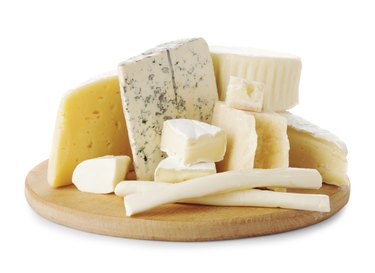
The National Kidney Foundation reports that milk and yogurt are high potassium foods. Accordingly, the Foundation recommends that kidney patients whose serum potassium is more than 5.0 mg/dl consume no more than one cup of milk or a 1/2 cup of yogurt a day. Since cheese is also made from milk, it is reasonable to suspect that cheese is a high potassium food as well. However, since different cheeses have different levels of potassium, the answer is a little more complex.
Potassium
Video of the Day
Potassium is a chemical element that is essential for life. Deficiency -- also called hypokalemia -- is very rare because potassium is found in most foods. Healthy bodies regulate concentration of potassium on both sides of the cell's membrane because the difference between intracellular and extracellular potassium concentrations makes it possible for nerves to fire. The kidneys filter excess potassium from the blood so that these concentrations remain stable.
Video of the Day
Kidney Patients
As patients with chronic kidney disease approach end stage disease, they often meet with a renal dietitian regarding dietary issues. As the kidneys become more compromised and less able to filter blood, serum levels of potassium start to increase. When nerves fail to fire properly, irregular heart beats or even heart attacks can result. This problem can be controlling by limiting dietary potassium, including high-potassium cheeses.
High-Potassium Cheeses
High-potassium cheeses are those that have more than 200 mg in a single serving. Generally, cheeses with large serving sizes are higher in potassium. For example, with 217 mg of potassium, 1 cup of low-fat cottage cheese is considered a high-potassium food. Likewise, 2/3 of a cup of ricotta cheese is considered a high-potassium food because it has 205 mg of potassium.
Low-Potassium Cheeses
Cheeses that are customarily eaten in small servings are considered low-potassium foods. For example, with only 28 mg of potassium, 1 oz. of cheddar is a low-potassium food. Likewise, blue cheese has 73 mg of potassium per ounce, and 1 tbsp. of low-fat cream cheese has only 28 mg. However, portion control is important because eating too much of these cheeses can introduce too much potassium for people who need to restrict total potassium.
Kidney patients who have high potassium levels should check with their nephrologist or renal dietitian before eating cheese because if the kidneys cannot filter potassium, they often cannot filter phosphorus. Since even small quantities cheese are almost invariably high in phosphorus, it should be eaten sparingly, regardless of potassium content, if your phosphorus levels are high.
- MedLinePlus: Potassium in Diet
- Drugs.com: Potassium Content Of Foods List
- National Institute of Diabetes and Digestive and Kidney Diseases: Eat Right to Feel Right on Hemodialysis
- USDA National Nutrient Database: Blue Cheese
- National Kidney Foundation: Potassium and Your CKD Diet
- National Kidney Foundation: Phosphorus and Your CKD Diet